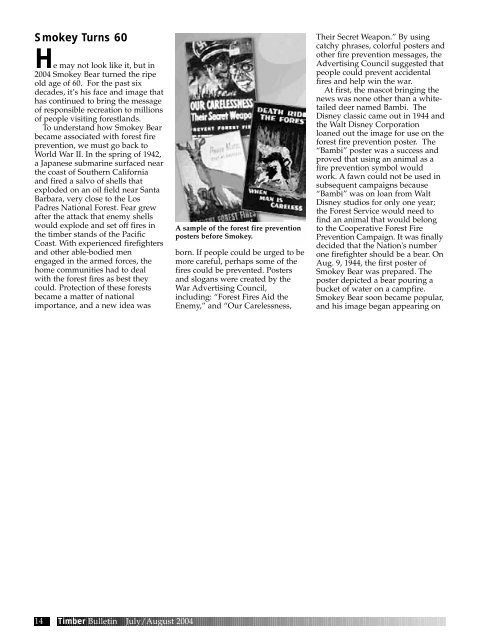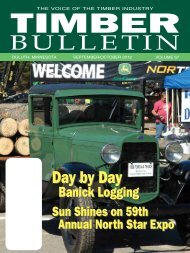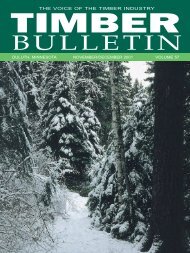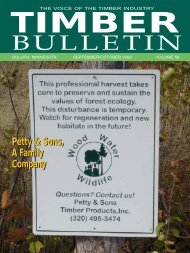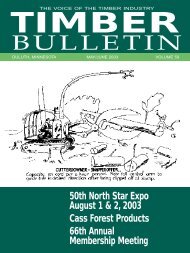Timber Bulletin Jul/Aug - Minnesota Forest Industries
Timber Bulletin Jul/Aug - Minnesota Forest Industries
Timber Bulletin Jul/Aug - Minnesota Forest Industries
Create successful ePaper yourself
Turn your PDF publications into a flip-book with our unique Google optimized e-Paper software.
Smokey Turns 60<br />
He may not look like it, but in<br />
2004 Smokey Bear turned the ripe<br />
old age of 60. For the past six<br />
decades, it’s his face and image that<br />
has continued to bring the message<br />
of responsible recreation to millions<br />
of people visiting forestlands.<br />
To understand how Smokey Bear<br />
became associated with forest fire<br />
prevention, we must go back to<br />
World War II. In the spring of 1942,<br />
a Japanese submarine surfaced near<br />
the coast of Southern California<br />
and fired a salvo of shells that<br />
exploded on an oil field near Santa<br />
Barbara, very close to the Los<br />
Padres National <strong>Forest</strong>. Fear grew<br />
after the attack that enemy shells<br />
would explode and set off fires in<br />
the timber stands of the Pacific<br />
Coast. With experienced firefighters<br />
and other able-bodied men<br />
engaged in the armed forces, the<br />
home communities had to deal<br />
with the forest fires as best they<br />
could. Protection of these forests<br />
became a matter of national<br />
importance, and a new idea was<br />
A sample of the forest fire prevention<br />
posters before Smokey.<br />
born. If people could be urged to be<br />
more careful, perhaps some of the<br />
fires could be prevented. Posters<br />
and slogans were created by the<br />
War Advertising Council,<br />
including: “<strong>Forest</strong> Fires Aid the<br />
Enemy,” and “Our Carelessness,<br />
Their Secret Weapon.” By using<br />
catchy phrases, colorful posters and<br />
other fire prevention messages, the<br />
Advertising Council suggested that<br />
people could prevent accidental<br />
fires and help win the war.<br />
At first, the mascot bringing the<br />
news was none other than a whitetailed<br />
deer named Bambi. The<br />
Disney classic came out in 1944 and<br />
the Walt Disney Corporation<br />
loaned out the image for use on the<br />
forest fire prevention poster. The<br />
“Bambi” poster was a success and<br />
proved that using an animal as a<br />
fire prevention symbol would<br />
work. A fawn could not be used in<br />
subsequent campaigns because<br />
“Bambi” was on loan from Walt<br />
Disney studios for only one year;<br />
the <strong>Forest</strong> Service would need to<br />
find an animal that would belong<br />
to the Cooperative <strong>Forest</strong> Fire<br />
Prevention Campaign. It was finally<br />
decided that the Nation's number<br />
one firefighter should be a bear. On<br />
<strong>Aug</strong>. 9, 1944, the first poster of<br />
Smokey Bear was prepared. The<br />
poster depicted a bear pouring a<br />
bucket of water on a campfire.<br />
Smokey Bear soon became popular,<br />
and his image began appearing on<br />
14<br />
<strong>Timber</strong> <strong>Bulletin</strong> <strong>Jul</strong>y/<strong>Aug</strong>ust 2004


